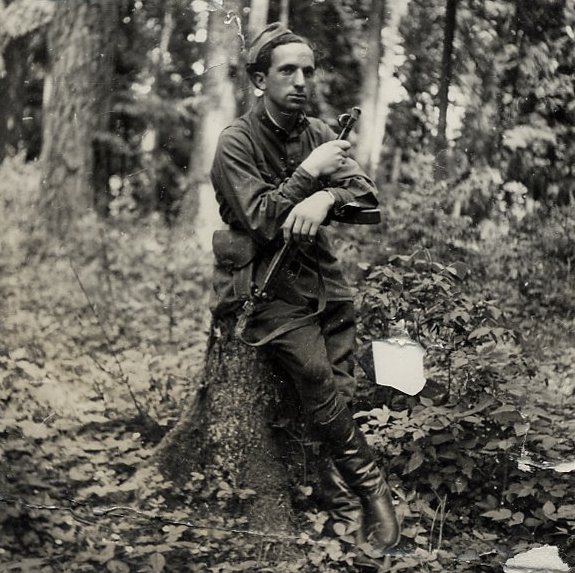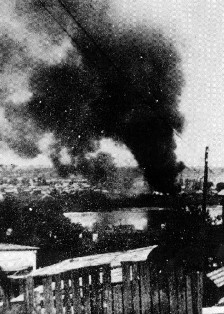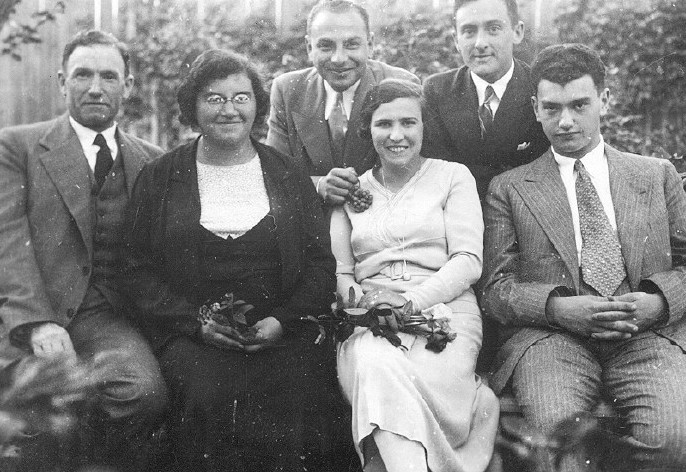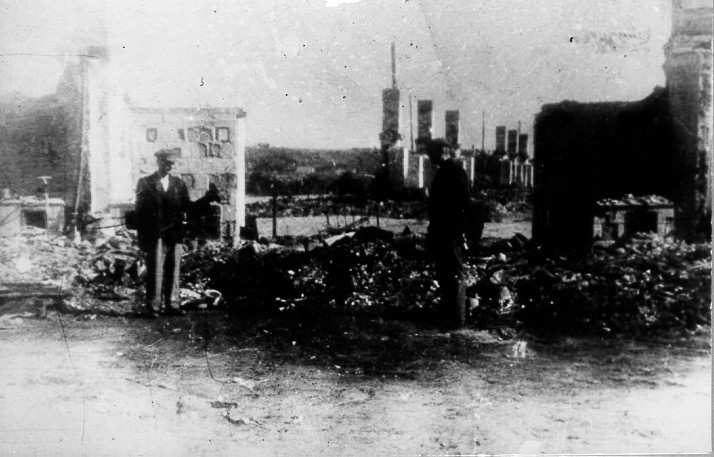Holocaust Education & Archive Research Team |
Revolt & Resistance
Acts of Resistance
Jewish Resistance
Groups Jewish Resistors Allied Reports Anti-Nazi Resistance Nazi collaborators
| ||||
The Gelpernus Diary Resistance in the Kovno Ghetto Chaim Yelin & Dimitri-Ghelpernus
Part VII "Work Camps"
1. JEWISH CAMPS
Ghetto territory was constantly reduced. Hundreds and thousands of people were taken from there to so-called "working camps" or "Jewish camps" situated in the suburbs of Kovno - Aleksotas, Shanchai and some small towns - Kedainiai, Laishiadoris, Raudondvaris, Palemonas, Babtai and then to Ajerelis and Panevejis. All those camps were "branches" of Kovno ghetto, and later - "Kovno concentration camp".
The organization tried to keep its members out of those labour camps. There was even less possibility of an armed struggle there than in the ghetto. However, in those camps people appeared who made up near or far periphery of the organization. Wide Jewish masses strived for such struggle. This was proved by the appearance of underground antifascist movement in all camps.
Members of that movement sought and found contacts with the ghetto movement which played a leadership role for all fighters in "labour camps". Instructions for sabotage acts were regularly sent to the camps. Groups for partisan bases were made up there. Much attention was paid to using local conditions for obtaining weapons. They made contact with local population thanks to their messengers.
It was not easy to keep the contact between the ghetto and camps. Messengers frequently simulated illnesses to get into ghetto hospital. Doctors Goldberg and Shapiro, organization sympathizers, helped them with this. People, who were sent from the camps to the centre - ghetto - to get their meagre food rations, also were helpful in sustaining contacts.
In a Jewish camp in Aleksotas headed by psychopath unterscharfuerer SS Karl Mich doctor Abraam Silber, Shmuel Saidelson and Benzl Preis set up an active antifascist group. This camp was called "prisoners' of war" camp because previously Soviet prisoners of war were kept there. They died after experiencing inhuman conditions.
The organization received a large number of bullets and military ammunition: underground fighters stole them from German military warehouses where they were sent for forced work. Moishe Kaltinovsky and Gordon were leaders of Shanchiai antifascist movement. Even in a small camp in Palemonas there was a resistance group.
As disappearance of individual prisoners from a camp meant danger for the whole camp Kaishiadoris underground fighters prepared a break-out for a large group of people. In April 1944 over 40 Jews led by Shimon Kweskin, Woolf Miasnik, Josl Borkan and others managed to escape from the camp and join partisans in Rudnizky forest. Germans liquidated the camp after their escape.
The ghetto organization kept a close contact with a camp in Kedainiai from the very start. This camp was supplied with political literature, instructions for practical work. Camp fighters did their best to harm Germans. Rivka Levi and Alter Sadinsky led Kedainiai movement. The fighters established a contact with a small acting partisan group (commander - P.Z.Vasilenko) which operated from forests near Kedainiai and agreed on a camp group joining the partisans. But only ten people managed to break out while the rest fell into fascists' hands. Braina and Sheina Levi, Sonia Bloshtein and Ethel Karlin were caught while trying to get through the barbed wire.
Kitel himself arrived from Kovno to carry out investigation. In spite of all efforts by gestapo he failed to get a single word. Tortured women were finally shot. During their execution they stood with their heads high up, they spat into German faces. Braina Bloshtein (* previously due to a misprint she was referred to as Braina Levi) had time to shout, "Heads higher! Our comrades will revenge us!"
5. IN A CONCENTRATION CAMP
Kovno ghetto, which for some time had been referred to as "Kovno concentration camp", became a camp soon after the "children's action". Territory occupied by Jews was reduced once again. "The Council of Elders for the Jewish population" was dissolved and one person was put instead - "camp elder".
The band of "law and order" representatives poisoned daily life. traitors Benzion Jiamaitis and Woolf Vilenchuk served their gestapo masters especially hard. They kept everyone in awe. But these scum could not escape a terrible death: Jiamaitis was punished by the Jews whom he persecuted before (* he was torn apart).
Jewish work brigades were substituted by Arian "kapos" - German criminals brought here from German concentration camps and put into isolated area of the ghetto. All ghetto buildings were numbered and called "blocks". Each "block" had a "block elder". Germans had carried out one more registration of the population which put the number of the central camp (former ghetto) residents at about seven thousand people. Every morning they checked each block numbers. A single missing person meant extermination for everyone in that block including "the elder".
Germans frequently inspected blocks, watched their residents. Fascists did not waste time on trying to find out the truth - any breach of "camp regulations" led to people being put into ghetto prison. Then "the offenders" were transferred to the 9th fort in black cars... Gestapo terror in the city became also unbearable. Resistance fighters, still at large, had to go deeper underground. There was a temporary break in communication between the two organizations.
But even in those conditions remaining leaders of the ghetto organization continued their work - they prepared new groups for Rudnizky forest. People could be delivered there only by transport. A driver was found. He agreed to take Jews who allegedly wanted to hide in the country. In the evening a vehicle was waiting for people in a side street in Villiampole, some 1.5 kilometres from the ghetto. The organization helped all of its members to leave the ghetto. All took up their positions in the vehicle.
Suddenly, after they crossed a bridge over the river Neris, the driver stopped and bullets started flying. It became clear - the driver was a traitor. Aba Diskant who was accompanying the group killed the traitor immediately. The fighters began exchange of fire with the gestapo men who had surrounded the vehicle. In the unequal battle many people died.
Among them energetic, enterprising committee member engineer Shimon Ratner, cheerful Saul Finkel who for a long time was responsible the organization depot, brave messenger Liuba Schwartz, partisans Menashe Sapojnikov, Moishe Marshak,Josef Manaiskin, Israel Shapiro with his wife. The rest managed to break through under the cover of darkness. Among fascists killed by the Jewish partisans was infamous sadist from Kovno gestapo, executioner of "criminal" Jews -Will.
Armed Plechavichus bands, formed by Germans to fight partisans, were raging on the roads to Rudnizky forest. A secret order to drivers from Kovno gestapo reached the organization: if Jews asked them to take them from Kovno, drivers must agree and then inform gestapo. The failure of the last group was most a result of that order. Ghetto fighters tried to set up a partisan base nearer Kovno. Scouts were sent in different directions.
Benzl Prais, Avram Rosin and Shafransky left for Jeimiai. They learned from local farmers that partisan groups appeared there only at times. Having left one person to wait for those partisans the other two returned to Kovno.
A scouting trip to the forest near Kaslu Ruda, 30-40 kilometres from Kovno, turned out to be more successful. The ghetto organization began setting up a partisan group on the basis of the collected information. Three groups of fighters left for that forest. All three were guided by Iren Berman. The third group came twice under fire from policemen. Iren Berman,a brave seventeen-year-old who did this journey more than once, died in the shooting. Meer Silber also died in that fight. Local farmers, especially M.Pechkis, helped the partisans who reached the forest of Kaslu Ruda.
In order to leave for the forest partisans had "to leave" Kovno concentration camp"(former ghetto) over barbed wire. Josl Michles and Peisach Shater headed this dangerous operation. At times they had to wait for two to three days for the right moment. Many people lost their lives while getting over the fence. In particular, trustworthy messenger Rachil Kaz and komsomol member Sonia Goldschmidt died while trying to leave the ghetto to perform a task for the organization.
At the same time they tried to re-establish contacts with the partisans of Rudnizky forest. Four well-armed people went there - Aba Diskant (group's guide), Ruvim Gorgel, Tev'e Pilovnik and Menachem Rubin. But 30 kilometres from Kovno the group met Germans. All four died in the fight. Some attempted to get to the forest on their own. The organization helped them to prepare the route and get over the fence.
Gradually new friends were found in the city - comrades-in-arms. Maria Leshchinskiene showed self-sacrifice more than anyone else. Neglecting her poor health and the fact that antifascist work had already cost her husband's life she devoted herself completely to the underground activity risking hers and her children's lives. Lishchinskiene's house was situated near ghetto - it became a depot and a meeting place for those who left for the forest and partisans. Lishchinskiene came daily to the ghetto gates to receive instructions and letters.
One could see her house from the ghetto. When Lishchinskiene had information for the ghetto fighters she used to put out clothes of certain colour for drying outside her loft window. Every colour had its meaning. Thus, reliable one-way communication was set up. Under the floorboards of her entrance hall there was a bunker for hiding weapons. In that bunker ghetto messengers and partisans hid on numerous occasions during German round-ups.
Contacts were established with comrade "Laisvutis" (Musteikis) who returned to Kovno underground. Dmitry Galperin met him several times in the city. They planned to set up an underground printing house for printing leaflets and appeals to the population. With this aim the organization gave their city friends a rotator and other printing equipment.
Partisan and ghetto messengers used to treat the little house of Adolfas Gudas on the banks of the river Neris like their own. It was a very convenient place for illegal meetings. The owner of the house and his wife let antifascists use it. Several times Gudas took Jewish partisans going to the forests of Kaslu Ruda over the river Neman in his boat. Thus the chain of brotherly solidarity between nations suffering under invaders' yoke became stronger.
In the middle of June 1944 came a request from partisans living in Kaslu Ruda forests to send new armed groups. Benzl Preis, Avrom Rosin, Shmuel Daich and others left immediately. On their way there they met a group of Soviet paratroopers led by a major. The partisans established a contact with the paratroopers and put them in touch with the ghetto organization. Messenger "Tonia" was later put in charge of keeping the contact. Swift advance by the Soviet Army brought about rapid developments in the situation. In a few days advanced detachments of the Soviet troops approached the Lithuanian border.
Again fascists gave vent to their anger on the ghetto Jews. "Kovno concentration camp" was surrounded by a triple number of guards armed with submachine-guns. Many men from SS, Gestapo, Austrian (Vienna) SD, SS units formed from Hungarian "Volksdeutche" and Riga police were sent here. Kovno firemen were on full alert on the outer side of the ghetto fence. The final liquidation of Kovno ghetto began. Germans issued an order: at the designated hour all Jews had to gather at the ghetto gates for transportation to Germany, further from the front...
Commandant Goeke ordered the former chairman of the Council of Elders, Elkes, to visit him and told him: "We want to spare the Jews the danger of being in the front-line zone... Kovno Jews will be accommodated in well-organized camps in Germany,a country of high civilization and culture. They are not just camps, they are model-camps... That is why you must persuade Jews not to hide but to gather at designated places for evacuation. We wish all Jews well..."
The ghetto organization announced mobilization. All resistance fighters had to come to either 24 Gimbuto street or 8 Broliu street or 10 Vitianio street or other places. An appeal to all members of the organization and ghetto residents was read out:
-No one should evacuate! Better to die here than to continue slavish existence!
The organization started digging a tunnel. In Kovno ghetto, situated in the suburbs, there were no sewage pipes which could serve the purpose well. The fact, that the ghetto fence stretched through wide unpopulated areas and waste land, made it impossible to dig a tunnel in "usual time". But they had to try everything. The most suitable house for this was a house at Broliu 2. From the basement of that house they began digging a tunnel which, they hoped, would bring them out to a sewage well at Krikshchiukaicho street outside ghetto. One needed to dig a tunnel of 30 metres long.
Extracted soil was taken out in small bags and even pockets and spread about without German knowledge. Though the tunnel was re-enforced with planks, suddenly, when the work was coming to an end and they were near the top layer, the soil began to sink. In spite of all efforts they failed to finish the tunnel. People tried to resist the transportation to Germany as much as they could. Dozens of people tried to get over the fence but were killed by guards' bullets.
Time allowed for evacuation came to an end. Yet only some people had been evacuated - the majority were hiding. Germans inspected all houses, sheds, wells, lavatories. Those who were hiding were ordered to come out. Otherwise, places where they were hiding, would be fire-bombed. But even the smell of burning houses over their heads did not persuade many people to leave...
From captured Jews Germans formed several trains and sent them to the west. But the numbers of evacuated Jews clearly did not satisfy the Germans. They tried one more thing - children found hiding during the so-called "children's action" were promised to be returned to their parents if places of hiding adults were revealed. (Goeke was ordered to take to Germany all registered in the ghetto Jews). Even this terrible torture did not bring results. So the children were murdered then. At the ghetto cemetery old people, invalids and also people wounded during the recent fires and explosions were executed by firing squads. Once again ghetto hospital was bombed and burnt.
The liquidation of the ghetto lasted for a week. Thousands of Jews hid for a week in basements - with no water, no food, no fresh air. Many could not cope - dead bodies lay next to those still alive... Ghetto executioners continued their work and did their bloody job -bombed basements, poured petrol over each building and then set them alight...
Kitel put a lot of effort into finding hiding Lipzer. The gestapo man wished to fulfil his promise that he made to his servant as a half‑joke: "You are my very good friend, Lipzer. That is why I shall bestow a special honour on you - I will shoot you myself..." Kitel was in luck. He found Lipzer in one of the discovered shelters and fulfilled his promise. In spite of only a small chance of success many tried to escape from guarded columns. They jumped off moving trains. Here are more details about one of such cases.
Several people headed by Kopeliansky, member of the ghetto organization, opened up floor-boards of the train. Through a hole in it the brave men tried to escape. But once the guards found out about it they stopped the train and ordered a chase. Kopeliansky had a revolver and some bullets. He started shooting and attracted attention to himself. In the uneven battle the komsomol member died but his friends could escape in the near-by forest. After July 13 no more trains were sent and all Jews were executed there.
During the liquidation the majority of the Jews died (about 4,000 people), while others were put into concentration camps in Stuthof and Dachau. (*in Stuthof they put women while in Dachau - men). Some of the evacuated Jews survived until the liberation by the Soviet Army. (*prisoners who survived Dachau camp were liberated by the allied forces in May 1945)
Simultaneously with the liberation of Kovno ghetto - central concentration camp - liquidation of all Lithuanian "Jewish camps" took place. Some people managed to escape from those camps. One antifascist group from concentration camp Ejerelis succeeded in organizing mass escape during their journey to Kovno railway. 140 of 300 prisoners of that camp escaped and joined partisans of Kaslu Ruda forest.
(* the escape succeeded because some of the guards from Vlasov brigade were persuaded to join them).
Continued...
[Part 1] [Part 2] [Part 3] [Part 4] [Part 5] [Part 6] [Part 8]
Sources: Chaim Bargman: translator Yiddish-Russian (L) with Robin O’Neil: translator Russian – English. Kaunas, Lithuania 2007 (photos: GFH, USHMM, & Private Collections)
Copyright H.E.A.R.T 2008 [Page design by Carmelo Lisciotto]
|




